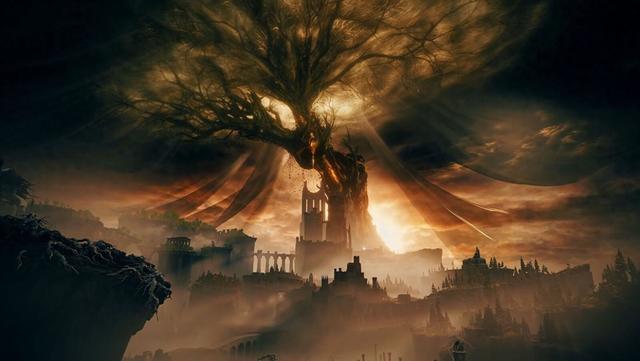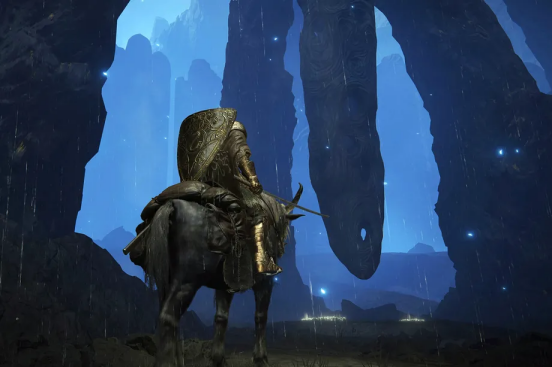
Last week, I concluded my adventure through "Shadow of the Erdtree DLC," a journey that was both a visual and emotional odyssey. Before embarking on this trip, I had heard various opinions from players regarding this DLC, with some voices claiming it shattered the gameplay principles and understanding I had accumulated from "Elden Ring," while others insisted it merely corrected my misconceptions and introduced innovative elements. This internal debate sparked my interest, prompting me to document my unique experience through a post, focusing on three aspects: visuals, map design, and combat experience. I will also attempt to analyze the reasons behind these differences.
I. Visual representation
"Shadows of the Erdtree" undoubtedly takes a significant step forward in visual presentation, with distinctively defined regions, each boasting unique landscapes and biomes. The use of color is daring and forward-thinking, transitioning seamlessly from the golden radiance of the Gravesite Plain to the misty blue-purple hues of the Cerulean Coast. However, this high saturation color bombardment, such as the lightning storms in the Spiked Mountains and the fiery blasts of the Flame Giant, while impressive, can also lead to aesthetic fatigue. Prolonged exposure to such visuals not only strains the eyes but also tires the mind, with certain areas like the Finger Ruins of Dheo becoming mentally taxing.

How do I describe this feeling of despair when, after navigating through an endless sea of oppressive grey fingers with a swarm of disgusting minions, you finally reach the center only to find something you have no idea how to unlock. There's no Grace, and nothing left to explore. You check it online and discover that this requires a side quest to unlock. The absence of a Grace means that you have to repeat your arduous journey all over again to reach here. That's bad.👆
II. Exploration Design
The DLC's levels are still structured hierarchically, categorized into three tiers: large, medium, and small. "Large" refers to the overall regions, such as the Gravesite Plains. "Medium" encompasses significant box-like architectures, like the shadow keep and the Ancient Ruins of Rauh(Yes, I categorize it as a "box”). It's worth noting that, despite being in the same tier, these two medium-sized box offer vastly different designs and experiences, both of which innovate upon the base game's box-like levels. For now, we'll refrain from delving deeper into these comparisons. "Small" comprises smaller areas of interest, like ruins and towers, which require focused exploration within a limited space. Anything smaller than these is not part of our current discussion.
1.The rewards do not match the expectation.
The ruins have visibly expanded and appear to offer more potential for exploration, yet many paths that, if found in the base game of the Elden Ring, would certainly lead to something worthwhile to discover, turn out to be empty in the DLC. This has led many players who enjoy meticulous exploration to circle around these vast ruins in disbelief, only to find a single Smithing Stone (4). It's undoubtedly bad news for those who take pleasure in exhaustive exploration, as the actual benefits of exploration have become negligible, rendering many exploratory actions meaningless.
2.The distribution density of Grace is uneven across different areas.
In the base game, the distribution of Grace was relatively even,with a consistent spacing between them. However, in the DLC, the density of Grace varies greatly across different regions. Some medium-sized box , like the Shadow Keep, have anastonishing two or three blessings within a very small area, while in other regions, players might ride for half the distance of Limgrave without encountering a single blessing.

It is evident that the distribution of Grace is highly uneven, with an abundance in Shadow Keep and a scarcity in the vast areas of Jagged Peak and Finger Ruins in the southeastern part.👆
Of course, the appearance of Grace is not distributed evenly based on a specific interval but rather determined by whether the area warrants multiple lives of exploration from players, essentially the level of exploration pressure. Therefore, I use the following criteria to judge whether a location should have Grace: the presence of box-like environments, ruins, catacombs, bosses, key NPCs, and whether it serves as a connection point between regions. The distribution of Grace in the DLC has made players who relied on its presence in the base game more acutely aware of this point, leading to some areas being surprisingly devoid of Grace, yet upon closer inspection, appearing reasonable and logical.
So, does this mean the developers intended for us to focus primarily on the box-like environments and merely glance over other areas? Clearly, that's not the case, which brings me to my next point.
3."The large map falls short of being 'open' as an open-world and lacks the 'refinement' expected of a grand box-like environment."
I'm actually quite nervous writing this sentence, as this multi-layered map design has been praised repeatedly by many. As a practitioner in the field, their map design is indeed "ingenious": The vast world in the DLC resembles more of a large-scale box garden than an "open world," with many seemingly connected areas actually being blocked off, requiring players to find key points to pass through. Therefore, it necessitates a meticulous exploration of the wilderness by the players, discovering these interconnected regions and the elusive paths between them. Some are truly outrageous, such as the fragments of the Ancient Ruin of Rauh's map, which are located by navigating a river course tens of thousands of miles away from the ruin itself.
However, as a non-traditional soulgame gamer who prefers a 60% open-world exploration and 40% box experience that is not overly hardcore, this layered experience leaves me feeling exhausted. It's as if I'm constantly navigating within a vast, rough box garden, where the sheer size prevents me from validating my judgments as promptly as in smaller box. As a result, I find myself frantically riding my horse across vast, barren lands with little to no exploratory value, all because of a misjudgment. Additionally, there are some bizarre one-way barriers that further complicate the experience. One area almost shattered my trust in Miyazaki, specifically the region below the hidden elevator in the Ancient Ruin of Rauh, after defeating the Dancing Loin. It turns out to be a complete one-way path, and the only way to return to other areas is through teleportation or death. That's bad. It doesn't align with my understanding of Elden Ring.
In contrast, I appreciate the pacing of the open-world exploration in Elden Ring more. The wilderness areas are relatively flat, with most of the pathways between regions clearly visible at first glance, eliminating the need for exhaustive back-and-forth searching. The sandbox, on the other hand, are sufficiently three-dimensional, offering intricate and Souls-like designs for those who wish to delve deeper into the architectural exploration. For those who prefer a more relaxed and enjoyable exploration, the wilderness provides just that, with surprises on both ends. The rewards found in the wilderness are no less impressive than those discovered within the box structures.
III. Combat Experience
When it comes to combat, I must admit it's not my forte, but I wholeheartedly agree with the criticisms from most players regarding the numerical balance and boss fights. Imagine being the newly crowned Elden Lord in the Lands Between, walking confidently into the Land of Shadow, donning your flashy outfit, only to be felled by a mere roadside dog. Swapping your stylish attire for practical, high-defense gear, you grit your teeth and finally make your way to the boss, intending to follow your usual routine of summoning allies, changing equipment, and chugging potions. However, even the first step—summoning your trusty brother:Mimic Tear—almost fails you.
Determined to press on, you resort to the tried-and-true tactic of rolling, but even three swift rolls aren't enough to evade the boss's devastating attacks. Frustrated and defeated, you reluctantly abandon your pride and delve into the very strategies you once dismissed, arming yourself with a massive shield and superweapon, determined to overcome this challenge by any means necessary, even if it means "wheelchair gaming" your way to victory.
I'm sure I'm not alone in feeling this way, many players must have lost the will to engage in epic battles with overly formidable bosses, finding themselves drained of the energy and motivation to continue.
Each of the three points mentioned above may have differing positive and negative impacts on different players, and it's not for me to judge whether breaking these expectations is right or wrong from a personal perspective. However, what cannot be denied is the profound realization they have imparted upon me: This is not merely a continuation of "The Story of Elden Ring," but rather a unique new world within the same backdrop, governed by its own distinct survival rules. Perhaps this is precisely the significance of the DLC—to offer a fresh experience within a familiar universe.